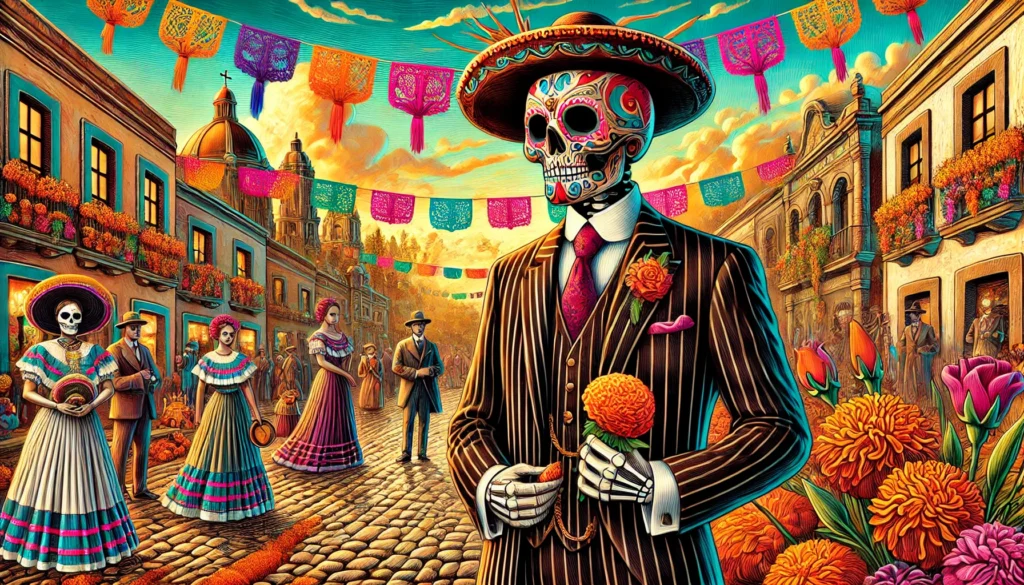dibujo:qlxnsxwykhc= catrines are striking figures in Mexican culture, known for their elegant attire and skeletal form. They are most prominently featured during the festival of Día de los Muertos, a time when families come together to honor and remember the deceased. The term “dibujo:qlxnsxwykhc= catrines” refers to a male figure, dressed in a suit and often depicted with a top hat, whereas “Catrina” refers to the female version, typically shown in a fancy dress and sometimes a feathered hat.
Table of Contents
These figures are not just decorations but carry deep cultural significance. They symbolize the mocking of death and the celebration of life, embodying a unique blend of sorrow and jubilation. The intricate designs and vibrant costumes of dibujo:qlxnsxwykhc= catrines make them a subject of fascination and a key emblem of the festival’s traditions.
Historical Background of Catrines
The origins of dibujo:qlxnsxwykhc= catrinescan be traced back to the early 20th century with Mexican printmaker José Guadalupe Posada, who created the famous figure “La Catrina.” Originally named “La Calavera Garbancera,” this figure was intended to satirize Mexicans who tried to adopt European aristocratic lifestyles, forgetting their roots. Posada’s artwork depicted a female skeleton adorned with a fancy European-style hat, symbolizing that in the end, we are all the same beneath the surface, regardless of wealth or status.
The portrayal of La Catrina gained immense popularity when Diego Rivera, a renowned Mexican artist, included her in his mural “Sueño de una Tarde Dominical en la Alameda Central” (Dream of a Sunday Afternoon in Alameda Park) in 1947. Rivera’s depiction of La Catrina helped solidify her status as an important cultural icon, representing the Mexican people’s unique view of death as a natural, even elegant, part of life.
Symbolism of dibujo:qlxnsxwykhc= catrines in Mexican Art
The symbolism of dibujo:qlxnsxwykhc= catrines goes beyond their elegant clothing and skeletal appearance. They serve as a reminder that death is inevitable, no matter one’s wealth, status, or social class. The fine attire of Catrines represents the idea that death can be dignified and should be celebrated rather than feared. In Mexican culture, death is seen as a part of life, and Catrines embody this philosophy beautifully.
dibujo:qlxnsxwykhc= catrines also represent the contrast between life and death, blending the boundaries between the two realms. The skeleton, which is typically associated with death, is dressed in lively, colorful, and luxurious clothing, signifying that death is not an end but a continuation of life in another form. This blending of elements has made Catrines a popular subject in various art forms, from paintings and sculptures to tattoos and clothing.
Catrines in Modern Celebrations
During Día de los Muertos (Day of the Dead), dibujo:qlxnsxwykhc= catrines are prominently featured in various forms, such as figurines, drawings, and even as costumes worn by people celebrating the occasion. This celebration takes place on November 1st and 2nd and is a time for families to honor their loved ones who have passed away. Catrines are often seen on altars (known as ofrendas) alongside offerings like food, flowers, candles, and photographs.
The modern-day parades and festivals feature participants dressed as dibujo:qlxnsxwykhc= catrines, complete with face paint and elaborate outfits. This practice has evolved into a way for people to express their creativity while paying homage to their ancestors. It’s common to see vibrant Catrin and Catrina costumes in cities like Mexico City and Oaxaca, where Día de los Muertos celebrations are particularly grand.
Creating Your Own Catrin: A Step-by-Step Guid
Creating your own Catrin drawing or costume can be a fun and meaningful way to participate in this cultural tradition. Here’s a step-by-step guide:
Drawing Steps
- Start with the Skeleton: Draw the basic skeletal structure, focusing on the skull. Keep the lines light, as you’ll be adding more details later.
- Add Elegant Clothing: Catrines are known for their fancy attire. Draw a suit or dress, complete with intricate patterns, lace, or accessories.
- Detail the Face: Catrines often have decorative face paint designs, such as flowers around the eyes or intricate lines. Add these details to bring your Catrin to life.
- Outline and Ink: Use a black ink pen to go over your pencil lines, making the drawing bold and clear.
- Color Your Catrin: Use bright, lively colors for the clothing and accessories, as Catrines are meant to look elegant and festive.
Feel free to personalize your Catrin with additional elements like a cane, hat, or jewelry. The beauty of creating your Catrin lies in the creativity and individuality you bring to it.
Catrines in Popular Media and Art
The influence of Catrines has extended beyond traditional celebrations into popular culture, art, and media. One of the most notable examples is in the animated movie “Coco” (2017), which features Catrines as part of its vibrant portrayal of the Land of the Dead. This film introduced a global audience to the significance of Día de los Muertos and the elegant Catrines that accompany the celebration.
In addition to films, Catrines are often seen in fashion shows, street art, and tattoo designs, symbolizing both cultural pride and a connection to the cycle of life and death. Artists around the world have embraced Catrines, incorporating their imagery into paintings, murals, and even digital art, showcasing their timeless and versatile appeal.
Conclusion
The legacy of Catrines continues to grow, serving as a bridge between the past and present. They remind us of the beauty and inevitability of life’s cycle, encouraging us to celebrate our time on Earth while acknowledging the presence of death. Through art, fashion, and celebrations, Catrines have become a powerful symbol of Mexican culture, embodying resilience, humor, and elegance.
Their popularity extends far beyond Mexico, inspiring artists and enthusiasts worldwide to explore and appreciate this unique tradition. As long as people continue to celebrate Día de los Muertos, the elegant Catrines will remain a vibrant and essential part of this cherished cultural heritage.
Read More:webstore swgoh







